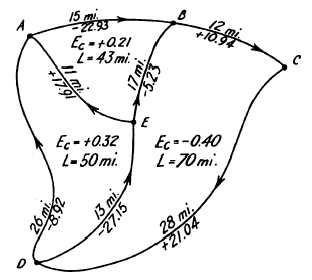Figure 7-5.–Adjustmmt of level nets.
For circuit BCDEB, the error of closure is –0.40 ft.
This is distributed among the lines in proportion to their
lengths. Thus, for the line BC, the correction is
(Notice that the sign is opposite to that of the error of
closure.) The correction of +0.07 ft is entered on the first
line of the column headed CORR and is added to the
difference in elevation (10.94 + 0.07 = +11.01). That
sum is entered on the first line under the heading CORR
DE (corrected difference in elevation). The same
procedure is followed for the remaining lines CD, DE,
and EB of circuit BCDEB.
The sum of the corrections must have the opposite
sign and be equal to the error of closure. The algebraic
sum of the corrected differences in elevation must equal
zero. The lines in circuit AEDA are corrected in the same
manner as BCDEB, except that the corrected value of
ED (+27.08 instead of +27.15) is used. The lines of
EABE are corrected using the corrected value of EA
(+17.97 instead of +17.91) and BE (+5.13 instead of
+5.23). In the column Cycle II, the procedure of Cycle
I is repeated. You should always list the latest corrected
value from previously adjusted circuits before
computing the new error of closure. The cycles are
continued until the corrections become zero. The
sequence in which the circuits are taken is immaterial as
long as they are repeated in the same order for each
cycle. Computations may be based on corrections rather
than differences in elevation.
TRAVERSE COMPUTATIONS
Traverse operations are conducted for mapping; for
large construction projects, such as a military post or an
Figure 7-6.—Computations required to balance the level net.
7-7


